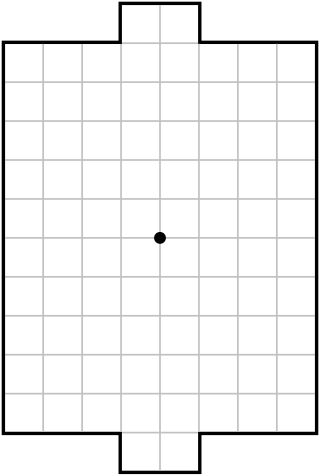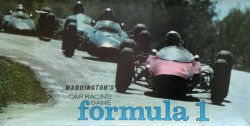
The Game of Life, also known as Conway's Game of Life or simply Life, is a cellular automaton devised by the British mathematician John Horton Conway in 1970. It is a zero-player game, meaning that its evolution is determined by its initial state, requiring no further input. One interacts with the Game of Life by creating an initial configuration and observing how it evolves. It is Turing complete and can simulate a universal constructor or any other Turing machine.

Chocobo Racing is a racing game developed and published by Square for the PlayStation, A spin-off of the Final Fantasy series and part of the Chocobo spin-off series. It was released in Japan in March 1999, followed by North America and Europe in August and October, respectively. The game's star and namesake is the Chocobo, with other figures from the Final Fantasy series, such as Mog the Moogle, the Black Mage, and Cid being part of the cast. Most of the game's soundtrack is composed using songs from previous Final Fantasy titles. As a formulaic kart racer, Chocobo Racing is often compared to Mario Kart and Crash Team Racing.

Battleship is a strategy type guessing game for two players. It is played on ruled grids on which each player's fleet of warships are marked. The locations of the fleets are concealed from the other player. Players alternate turns calling "shots" at the other player's ships, and the objective of the game is to destroy the opposing player's fleet.

A dragstrip is a facility for conducting automobile and motorcycle acceleration events such as drag racing. Although a quarter mile is the best known measure for a drag track, many tracks are eighth mile (201 m) tracks, and the premiere classes will run 1,000 foot (304.8 m) races. The race is begun from a standing start which allows three factors to affect the outcome of the race: reaction time, power/weight ratio, and traction.

A race track is a facility built for racing of vehicles, athletes, or animals. A race track also may feature grandstands or concourses. Race tracks are also used in the study of animal locomotion.

Paper soccer is an abstract strategy game played on a square grid representing a soccer or hockey field. Two players take turns extending a line representing the position of a ball until it reaches one of the grid's two-goal spaces. A traditional paper-and-pencil game, it is commonly played in schools and can be found in some magazines. Many computer implementations of the game also exist. Despite the game's simple rules, paper soccer has various expanded strategies and tactics.
Dirt track racing is a form of motorsport held on clay or dirt surfaced banked oval racetracks. Dirt track racing started in the United States before World War I and became widespread during the 1920s and 1930s using both automobiles and motorcycles, spreading throughout Japan and often running on horse racing tracks. There are a myriad of types of race cars used, from open wheel Sprint cars and Modifieds to stock cars. While open wheel race cars are purpose-built racing vehicles, stock cars can be either purpose-built race cars or street vehicles that have been modified to varying degrees. There are hundreds of local and regional racetracks throughout the United States and also throughout Japan. The sport is also popular in Canada, Mexico, Argentina, Brazil, Chile, Australia, New Zealand, South Africa and the United Kingdom.

Formula D is a board game that recreates formula racing. It was designed by Eric Randall and Laurent Lavaur and was originally published by Ludodélire. The rights to the game passed to EuroGames with the collapse of Ludodélire, and were in turn acquired by Asmodée Éditions. When Asmodée released their new edition, the game's name was shortened to Formula D and its rules updated to include street and import racing.

Circus Maximus is a chariot racing board game that was originally published by Battleline Publications in 1979, but is better known for the 1980 Avalon Hill edition. The game has become very popular at gaming conventions in an oversized form, with 10-foot (3.0 m)-long boards and baseball-sized chariots.

Top Gear Overdrive is a racing game released in 1998 for the Nintendo 64 and the sequel to Top Gear Rally. The game has support for high-resolution graphics if used with the Expansion Pak and features music from the band Grindstone.
Motion planning, also path planning is a computational problem to find a sequence of valid configurations that moves the object from the source to destination. The term is used in computational geometry, computer animation, robotics and computer games.

IndyCar Racing is a racing video game by Papyrus Design Group released in 1993. Papyrus, consisting of David Kaemmer and Omar Khudari, previously developed Indianapolis 500: The Simulation, released in 1989.

There are many variations of the simple rules of Go. Some are ancient digressions, while other are modern deviations. They are often side events at tournaments, for example, the U.S. Go Congress holds a "Crazy Go" event every year.
Nakajima Satoru F-1 Hero is a video game developed by Human Entertainment released for the Nintendo Entertainment System in 1990. It starred American Indy car driver Michael Andretti, and featured the full sixteen-race schedule of the FIA Formula One World Championship circuit.

Nakajima Satoru Kanshuu F1 Grand Prix is a 1991 Sega Mega Drive Formula One video game based on the career of Satoru Nakajima, who was the first full-time Japanese racer in the history of Formula One. In fact, this was the first game that Nakajima endorsed for a Japanese video gaming system. The entire 1991 Formula One season can be re-enacted with any of the notable contenders from the prestigious Formula One racing organization.

Alfa Romeo Racing Italiano, known in Europe as SCAR - Squadra Corse Alfa Romeo, is a racing video game for the PlayStation 2, Windows and Xbox. It was developed by Milestone srl and released in 2005.
The following is a glossary of terminology used in motorsport, along with explanations of their meanings.

Speed Circuit is a Formula I racing game published by 3M in 1971, and then republished by Avalon Hill in 1977.

Formula 1 is a motor racing themed board game designed by John Howarth and Trevor Jones and originally published by Waddingtons of Leeds, United Kingdom in 1962.

The 2014 Legend SuperCup season was a legends car racing series that started over 25–27 April in Portimão, Portugal and ended over 17–19 October at the TT Circuit Assen, Netherlands. Legend SuperCup (LSC) was a part of Acceleration 2014, a series of festivals combining top class car and bike racing with music and entertainment. Next to LSC, there was the Formula Acceleration 1, based on the former A1 Grand Prix, the MW-V6 Pickup Series, based on the former Dutch racing series BRL V6, and the European Stock 600 and 1000 Series, which featured motorcycle racing for 15- and 16-year-olds. To attract young, yet serious, racing drivers, the 2014 LSC drivers' champion was promised half the budget for the 2015 MW-V6 Pickup Series season plus a test day in the MW-V6 car. As for the music, on Friday evenings, David Hasselhoff hosted "Celebrate the 80's and the 90's with The Hoff", a dance party featuring 2 Unlimited, Haddaway, Kim Wilde, and others. Saturday evenings saw performances of international DJs.


















